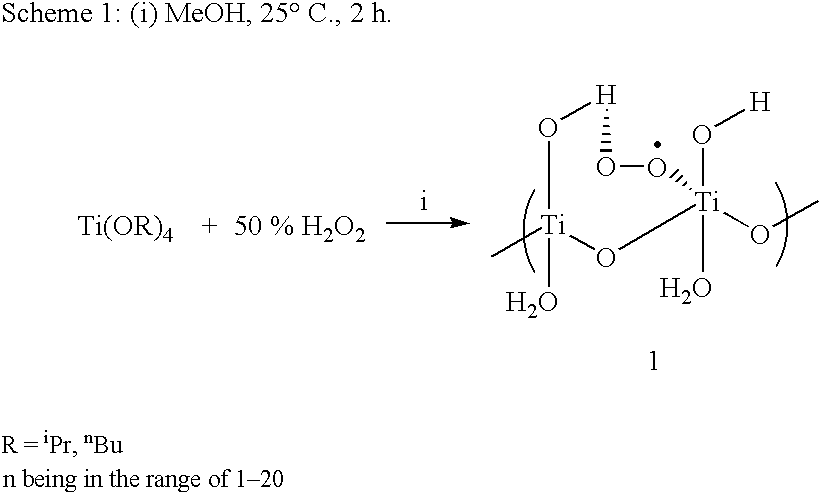Process for conversion of phenol to hydroquinone and quinones
a technology of hydroquinone and phenol, which is applied in the field of process for the conversion of phenol to hydroquinone and quinones, can solve the problems of difficult product separation, poor selectivity of catechol and hydroquinone, and tedious separation of these cyclic ligands
- Summary
- Abstract
- Description
- Claims
- Application Information
AI Technical Summary
Benefits of technology
Problems solved by technology
Method used
Image
Examples
example 1
Preparation of 1,4-hydroquinone
A mixture of phenol (5 mmol) and Ti-superoxide catalyst (125 mg, 20% w / w) in acetic acid (5 ml) was heated with stirring at 50-60° C. under inert atmosphere. To this' reaction mixture was added aq. 10% H2O2 (20 mmol) drop wise over 15 min. and heated for 2 h. After this, water (5 ml) was added and the reaction mixture was heated to reflux for 8 h. The catalyst was recovered by simple filtration and 1,4-hydroquinone formed (20%) was separated by chromatographic purification.
example 2
Preparation of 1,4-hydroquinone
A mixture of phenol (5 mmol) and Ti-superoxide catalyst (125 mg, 20% w / w) in acetic acid (5 ml) was heated with stirring at 50-60° C. under inert atmosphere. To this reaction mixture was added aq. 50% H2O2 (20 mmol) drop wise over 15 min. and heated for 1 h. After this, water (5 ml) was added and the reaction mixture was heated to reflux for 7 h. The catalyst was recovered by simple filtration and 1,4-hydroquinone formed (61%) was separated by chromatographic purification.
example 3
Preparation of 1,4-hydroquinone
A mixture of phenol (5 mmol) and Ti-superoxide catalyst (125 mg, 20% w / w) in acetic acid (5 ml) was heated with stirring at 50-60° C. under inert atmosphere. To this reaction mixture was added aq. 30% H2O2 (20 mmol) drop wise over 15 min. and heated for 1 h. After this, water (5 ml) was added and the reaction mixture was heated to reflux for 6 h. The catalyst was recovered by simple filtration and 1,4-hydroquinone formed (60%) was separated by chromatographic purification.
PUM
| Property | Measurement | Unit |
|---|---|---|
| Temperature | aaaaa | aaaaa |
| Temperature | aaaaa | aaaaa |
| Temperature | aaaaa | aaaaa |
Abstract
Description
Claims
Application Information
 Login to View More
Login to View More - R&D
- Intellectual Property
- Life Sciences
- Materials
- Tech Scout
- Unparalleled Data Quality
- Higher Quality Content
- 60% Fewer Hallucinations
Browse by: Latest US Patents, China's latest patents, Technical Efficacy Thesaurus, Application Domain, Technology Topic, Popular Technical Reports.
© 2025 PatSnap. All rights reserved.Legal|Privacy policy|Modern Slavery Act Transparency Statement|Sitemap|About US| Contact US: help@patsnap.com



